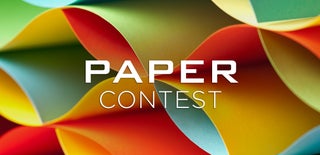Introduction: Real-Life Animated Greeting Cards
This is an easy technique that adds an animated picture to a greeting card. This is what you will need:
- A greeting card
- A laser printer (not sure if inkjet would work for this project)
- Laser printer transparency sheets
- Scissors
- Clear tape
Step 1: Print and Trim the Patterns
Print "planetary_gear.pdf" on regular paper.
Print "transparent_grid.pdf" on a transparency sheet.
When printing, be sure to select "Actual size" rather than "Fit"
Orient both sheets so the lines run vertical.
Trim the two sheets so that they fit inside the greeting card, but cut the the transparency slightly larger than the paper with the gears.
Step 2: Assemble the Mechanism
Use some clear tape to attach the gear pattern a millimeter or two the right of the seam on the greeting card, on the opposite side. The idea is to make a hinge so that as the card opens and closes, it moves the pattern a millimeters or so in either direction.
Then, cover the gear pattern with the transparency mask and tape it down on three sides opposite the hinge. Take care to align the vertical lines on the mask and pattern as well as you can, as this is crucial for the effect to function properly.
Step 3: How It Works
The trick is that the gear pattern is subdivided into groups of four columns. The pixels for each column are taken from a corresponding frame in the animation. When you place the semi-transparent mask over the image, it lets through only the parts from a single frame while blocking out all the others. As you slide the mask, it cycles through the four frames, giving the illusion of motion.
The downside of this technique is that the mask is mostly dark, so the more frames in the animation, the darker it will make the animation look. Four frames isn't enough for most animations, but the turning gears work particularly well for giving the illusion of a much longer sequence.
Step 4: TL;DR: How I Generated the Pattern Using OpenSCAD and GIMP
I made the planetary gear animation in OpenSCAD and used the "Animate" feature to generate four frames. For those who are interested, the ".scad" files are attached.
I then used the GIMP to create a custom 20x20 pattern that consisted of one line of white pixels and three lines of black pixels repeated five times. This pattern was used for the mask. I installed this into my GIMP patterns directory as a custom pattern (see tutorial here or see the pre-made "four-frames.pat" file that I attached).
I then opened the four animation frames I exported from OpenSCAD into GIMP using the "Open as Layers..." feature. I changed the mode of the images to "Indexed Color" and selected the 1-bit B&W palette. I changed the resolution of the image to 150 dpi, so that it would print okay on a 300 dpi laser printer.
For each layer, I right clicked and selected "Add Layer Mask..." and then checked "Show Layer Mask" for each layer. I used the Bucket Fill tool to fill each layer mask with the custom mask pattern. The mask makes it so just one line out of every four will be shown, with the others masked out.
It is then necessary to stagger the masks so that each layer contributes a different line. I zoomed the document to 800%, scrolled to the top of the image, and used the Move Tool to move the white row of pixels in the 1st mask to the 1st line of the image, to the 2nd line of pixels for the 2nd mask, to the 3rd line of pixels for the 3rd mask, and to the 4th line of pixels on the 4th mask. I then unchecked "Show Layer Mask" and "Edit Layer Mask" for each layer, giving me the composite image.
The resulting file was saved as "greeting_card_template.xcf".
If you want to make a new pattern, you can do so by opening that file. Right click each layer and select "Disable Layer Mask" for each layer. Also make sure "Show Layer Mask" and "Edit Layer Mask" are unchecked. You should now be able to switch from layer to layer and replace the gears with four new frames of your choosing. Then, re-enable the layer masks on each layer to make a composite image that interleaves all four frames.

Participated in the
Paper Contest













